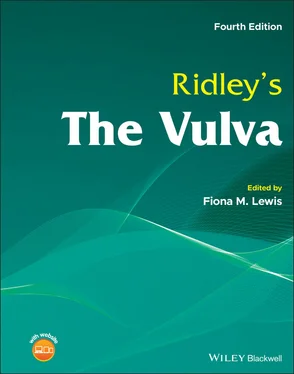Ridley's The Vulva
Здесь есть возможность читать онлайн «Ridley's The Vulva» — ознакомительный отрывок электронной книги совершенно бесплатно, а после прочтения отрывка купить полную версию. В некоторых случаях можно слушать аудио, скачать через торрент в формате fb2 и присутствует краткое содержание. Жанр: unrecognised, на английском языке. Описание произведения, (предисловие) а так же отзывы посетителей доступны на портале библиотеки ЛибКат.
- Название:Ridley's The Vulva
- Автор:
- Жанр:
- Год:неизвестен
- ISBN:нет данных
- Рейтинг книги:3 / 5. Голосов: 1
-
Избранное:Добавить в избранное
- Отзывы:
-
Ваша оценка:
- 60
- 1
- 2
- 3
- 4
- 5
Ridley's The Vulva: краткое содержание, описание и аннотация
Предлагаем к чтению аннотацию, описание, краткое содержание или предисловие (зависит от того, что написал сам автор книги «Ridley's The Vulva»). Если вы не нашли необходимую информацию о книге — напишите в комментариях, мы постараемся отыскать её.
Ridley’s The Vulva
Ridley’s The Vulva
Ridley's The Vulva — читать онлайн ознакомительный отрывок
Ниже представлен текст книги, разбитый по страницам. Система сохранения места последней прочитанной страницы, позволяет с удобством читать онлайн бесплатно книгу «Ridley's The Vulva», без необходимости каждый раз заново искать на чём Вы остановились. Поставьте закладку, и сможете в любой момент перейти на страницу, на которой закончили чтение.
Интервал:
Закладка:
Table 1.2 Classification of disorders of sexual development (DSDs).
| 1. Sex chromosome DSD |
| Turner syndrome (45,X) Klinefelter syndrome (47,XXY) Mosaicism 45,X/46,XY Triple XXX syndrome XXYY syndrome |
| 2. 46,XX DSD |
| Androgen induced/androgen excessCongenital adrenal hyperplasia (CAH)Placental aromatase deficiencyGlucocorticoid receptor mutationMaternal androgen secreting tumours (e.g. luteomas)Androgenic drug exposure OthersSyndromic associations, e.g. cloacal dystrophiesMüllerian agenesisVaginal atresiaUterine anomalies |
| 3. 46,XY DSD |
| Disorders of androgen synthesis and actionLH receptor mutationsSmith–Lemli–Opitz syndromeCholesterol side chain cleavageSteroid protein mutations5∝‐reductase deficiencyAndrogen insensitivity syndromeLeydig cell agenesis OthersSyndromic association of male genital development, e.g. hand‐foot‐genital, cloacal dystrophiesPersistent Müllerian duct syndromeCryptorchidismCongenital hypogonadotropic hypogonadism |
| 4. Disorders of gonadal developmentComplete or partial gonadal dysgenesisOvotesticular DSD |
Mosaicism
45,X/46,XX mosaicism and X chromosome abnormality
This form of mosaicism is the most common cause of ovarian dysgenesis after Turner’s syndrome. One gonad may be of the streak type and the contralateral gonad a normal or hypoplastic ovary; alternatively, both ovaries may be either normal or hypoplastic. There are fewer of the somatic abnormalities associated with Turner’s syndrome, the phenotype is invariably female, and some will menstruate and even be fertile.
45,X/46,XY MOSAICISM AND Y CHROMOSOME ABNORMALITY
A highly diverse phenotype is encountered in 45,X/46,XY mosaicism since the presence of a Y‐bearing cell line may induce some testicular differentiation. Such individuals may appear typically male or female or may possess ambiguous external genitalia with varied genital duct development. The prevalence of gonadal tumours in these patients can vary with phenotype and appears to be higher in those with a female phenotype [ 30].
46,XX DSD
The chromosomal makeup is 46,XX with the ovaries and Müllerian duct derivatives as normal. The external genitalia are abnormal. The clitoris is enlarged, variable degrees of labial fusion are seen, and the urethral opening may not be distinct from the vagina. The external genitalia of the male foetus are completely masculinised by 84–98 days. If a female foetus is exposed to significant androgen levels, in the presence of 5∝‐reductase, before the end of this period of development, complete virilisation will occur. Lower levels or later exposure will produce various forms of incomplete virilisation. The source of the androgen excess may be foetal, maternal, or exogenous.
Foetal androgen excess
Foetal androgen excess is generally due to forms of CAH. The most common disorder in this group is virilising CAH. This is usually an autosomal recessive inherited condition due to mutations in the CYP21A2 gene, leading to reduced 21‐hydroxylase activity. This in turn causes reduced levels of cortisol and aldosterone, a rise in ACTH, adrenal hyperplasia, and consequently high levels of 17‐hydroxyprogesterone and testosterone. As salt wasting and adrenal insufficiency in the neonatal period are serious complications, screening programmes are in place, and most cases are diagnosed in this period.
Typical CAH results in clitoromegaly, fusion of the labia majora, and a single perineal opening dividing proximally into the urethra and vagina. Expert surgery is required, but the timing of this can be difficult. The aim of surgical intervention is to bring the vagina to normal position on the perineum, to separate the distal vagina from the urethra, and to ensure an adequate vaginal introitus [31]. It is important to preserve clitoral innervation if clitoromegaly is to be reduced surgically. However, clitoromegaly can improve with time, so surgery for this can be delayed. The main complications of these procedures are incontinence and enuresis, wound breakdown, infection, and vaginal stenosis [32]. With follow‐up, most patients are sexually active but report reduced sensation.
Atypical presentations may not be diagnosed until adolescence or adulthood, and features can overlap with those of polycystic ovarian syndrome. Patients with CAH are at increased risk of diabetes, thromboembolic disease, and thyroid disorders [ 33].
There are other autosomal recessive forms of CAH giving rise to disorders of steroidogenesis. These include deficiencies of 11‐ß‐hydroxylase deficiency (CYP11B1 mutation), 3‐ ß‐hydroxysteroid dehydrogenase (HSD3B2 mutation), P450 oxidoreductase (POR mutation), aromatase (CYP19A1 mutation), and 17‐hydroxysteroid dehydrogenase. Deficiencies of 3‐ ß‐hydroxysteroid dehydrogenase and 17‐hydroxysteroid dehydrogenase reduce cortisol production and also impair the synthesis of sex steroids by the gonads and adrenals. With 3‐ ß‐hydroxysteroid deficiency, the only androgen synthesised is dehydroepiandrosterone (DHEA), which is relatively weak, and females with this deficiency are less virilised than those with the 21‐ or 11‐ß ‐hydroxylase deficient forms of CAH. With reduced levels of 17‐hydroxysteroid dehydrogenase, the female external genitalia are normal at birth, but no secondary sexual development occurs at puberty.
Maternal androgen excess
In rare instances, virilisation of the female foetus may occur if the mother is suffering from certain ovarian or adrenal tumours or if she has unrecognised CAH. The absence of virilisation in the mother does not exclude a maternal source of androgens since the level of androgen required to change the external genitalia of the early female foetus is much less than would be required to have the same effect on the adult female [34].
Exogenous androgen excess
Virilisation of the external genitalia of female infants has been frequently observed following maternal ingestion of testosterone or synthetic progestational agents during the first trimester of pregnancy [35]. Administration of such agents between the 8th and 12th weeks of gestation causes marked virilisation, but later in pregnancy they cause clitoral enlargement. These agents, as well as stilboestrol, were often prescribed in the past for women with recurrent miscarriage. Exposure to stilboestrol during intrauterine life is known to cause malformations in the reproductive tracts of both sexes, 46,XX DSD, and an increased incidence of cervical and vaginal neoplasia [ 36].
Intrauterine exposure to danazol, used in the treatment of endometriosis, has also been associated with virilisation of the female foetus, and in one study of 94 completed pregnancies in women taking danazol, 23 of the female offspring had genital abnormalities including clitoromegaly and fused labia [ 37].
Maternal cocaine use during pregnancy has been linked with ambiguous genitalia in both male and female infants, as well as other congenital malformations [38].
46,XY DSD
These disorders relate to patients with abnormalities of testicular differentiation or androgen synthesis or activity. The most common disorder of androgen synthesis is 5∝‐reductase deficiency secondary to mutations in the SRD5A2 gene. This enzyme is involved in the virilisation of the external genitalia during embryogenesis. The genitalia are ambiguous at birth, but at puberty can develop further male characteristics.
Читать дальшеИнтервал:
Закладка:
Похожие книги на «Ridley's The Vulva»
Представляем Вашему вниманию похожие книги на «Ridley's The Vulva» списком для выбора. Мы отобрали схожую по названию и смыслу литературу в надежде предоставить читателям больше вариантов отыскать новые, интересные, ещё непрочитанные произведения.
Обсуждение, отзывы о книге «Ridley's The Vulva» и просто собственные мнения читателей. Оставьте ваши комментарии, напишите, что Вы думаете о произведении, его смысле или главных героях. Укажите что конкретно понравилось, а что нет, и почему Вы так считаете.












